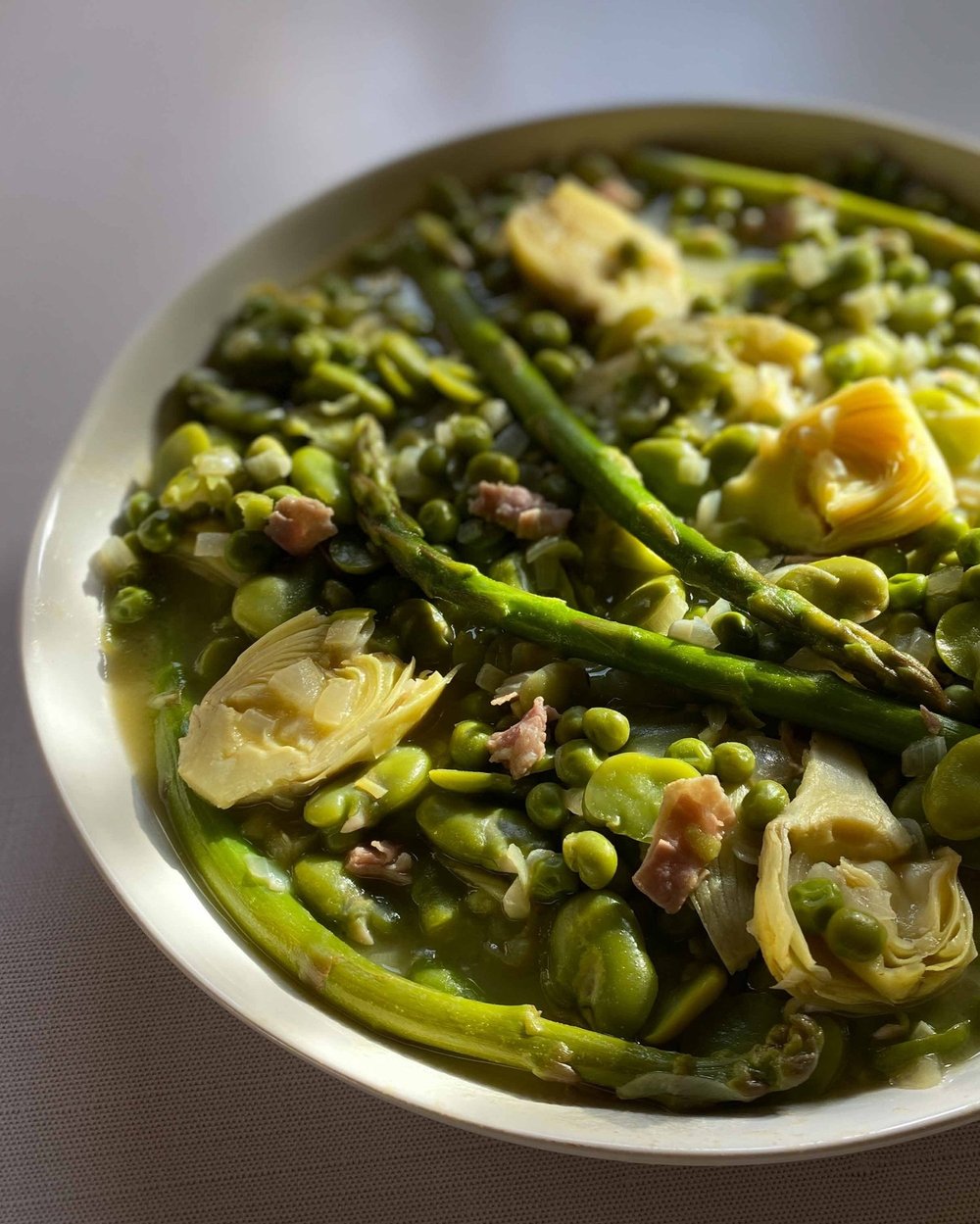Claudia Roden's Medley of Spring Vegetables
For those moments when you want to celebrate or evoke spring, this recipe for menestra de primavera — adapted from The Food of Spain by Claudia Roden — delivers big-time. Roden calls the dish, which is traditionally a soup, “one of the of the great vegetable dishes of Spain.” It’s a specialty of Narvarre and La Rioja.
READ: Why my desert-isle cookbook author would probably be Claudia Roden
Roden provides an easy cheat for when you don’t have fresh favas, peas and baby artichoke hearts: Use frozen ones. We used frozen peas and favas, and baby artichokes from a can (Trader Joe’s sells good ones). The vegetables in this dish get cooked to extreme tenderness, and the effect is fabulous: The dish is like spring comfort food.
If using fresh favas, or frozen ones that are still in their skin, be sure to peel off the skin of each before using. A few seconds in boiling will loosen the skins of fresh ones; they then slip off easily if knicked with the tip of a paring knife.
Note: You can make the dish a few minutes to an hour in advance and reheat it before serving, but if you do, the vegetables won’t be as green as they are in our photo.
Serves 4 to 6.
Ingredients
3 cups chicken broth
1 1/3 cups shelled fresh fava beans or defrosted frozen favas
4 fresh baby artichoke hearts, or canned or defrosted frozen ones, cut in half
1/2 pound asparagus (slim ones, if possible) hard bottom ends trimmed off
1 1/3 cups fresh peas or defrosted frozen peas
1/2 teaspoon salt (or more to taste)
1/2 large onion, chopped
2 tablespoons olive oil
1 garlic clove, finely chopped
2 thin slices serrano ham, prosciutto or bacon, chopped
1 1/2 tablespoons all-purpose flour
1 cup dry white wine
Instructions
1. Bring the broth to a boil in a medium saucepan. Add the fava beans and the artichoke hearts and simmer for 10 minutes (5 minutes if using frozen or canned), then add the asparagus and simmer for 5 minutes. Add the peas and salt, and cook just until the vegetables are tender. Remove from the heat.
2. In a medium skillet, heat the olive oil, then add the onion and saute over low heat until soft and translucent, about 6 or 7 minutes. Add the garlic and chopped ham, and stir for 1 minute. Sprinkle on the flour, and cook, stirring, until it acquires a little color, about 2 minutes. Gradually add the wine, stirring vigorously, and raise the heat to medium. Continue cooking, stirring frequently to loosen any flour stuck to the bottom, until the sauce thickens a little, a minute or two. Add 2 ladles of the broth the vegetables and cook, stirring frequently, for about 8 minutes, until the sauce is thick and velvety.
3. Pour the sauce over the vegetables, shake the pan, and cook until the vegetables are very tender, five or ten minutes. Taste and add salt, if necessary (you’ll probably need to, especially if you used not-very-salty broth). Serve the dish hot or warm.

Claudia Roden's Medley of Spring Vegetables
Ingredients
- 3 cups chicken broth
- 1 1/3 cups shelled fresh fava beans or defrosted frozen favas
- 4 fresh baby artichoke hearts, or canned or defrosted frozen ones, cut in half
- 1/2 pound asparagus (slim ones, if possible) hard bottom ends trimmed off
- 1 1/3 cups fresh peas or defrosted frozen peas
- 1/2 teaspoon salt (or more to taste)
- 1/2 large onion, chopped
- 2 tablespoons olive oil
- 1 garlic clove, finely chopped
- 2 thin slices serrano ham, prosciutto or bacon, chopped
- 1 1/2 tablespoons all-purpose flour
- 1 cup dry white wine
Instructions
- Bring the broth to a boil in a medium saucepan. Add the fava beans and the artichoke hearts and simmer for 10 minutes (5 minutes if using frozen or canned), then add the asparagus and simmer for 5 minutes. Add the peas and salt, and cook just until the vegetables are tender. Remove from the heat.
- In a medium skillet, heat the olive oil, then add the onion and saute over low heat until soft and translucent, about 6 or 7 minutes. Add the garlic and chopped ham, and stir for 1 minute. Sprinkle on the flour, and cook, stirring, until it acquires a little color, about 2 minutes. Gradually add the wine, stirring vigorously, and raise the heat to medium. Continue cooking, stirring frequently to loosen any flour stuck to the bottom, until the sauce thickens a little, a minute or two. Add 2 ladles of the broth the vegetables and cook, stirring frequently, for about 8 minutes, until the sauce is thick and velvety.
- Pour the sauce over the vegetables, shake the pan, and cook until the vegetables are very tender, five or ten minutes. Taste and add salt, if necessary (you’ll probably need to, especially if you used not-very-salty broth). Serve the dish hot or warm.




